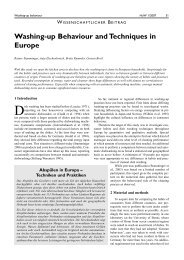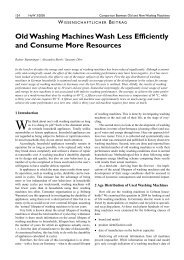Development of a novel mechatronic system for mechanical weed ...
Development of a novel mechatronic system for mechanical weed ...
Development of a novel mechatronic system for mechanical weed ...
Create successful ePaper yourself
Turn your PDF publications into a flip-book with our unique Google optimized e-Paper software.
Results and discussion<br />
After the measurement is completed the s<strong>of</strong>tware generates a report-file,<br />
containing general in<strong>for</strong>mation such as: date and time, sampling distance,<br />
distance between plants, additional in<strong>for</strong>mation about the measurement,<br />
distance from the soil surface, and settings <strong>for</strong> both sensors. The data set is a<br />
two dimensional array in which every row contains the value sampled with the<br />
position sensors, the values sampled with the RGB and laser sensor, time<br />
stamp, and centre position <strong>of</strong> the last detected plant. The time stamp is used <strong>for</strong><br />
calculation <strong>of</strong> the carrier’s average <strong>for</strong>ward speed in every sampling loop.<br />
5.1.1 Evaluation <strong>of</strong> the algorithm <strong>for</strong> detection <strong>of</strong> the<br />
plant centre position<br />
For detection <strong>of</strong> the plant centre position according to the algorithm described in<br />
chapter 5.1, VI-s were written. The calculation mechanism <strong>of</strong> the pattern’s<br />
centre position, as one <strong>of</strong> the key functions built-in the algorithm <strong>for</strong> detection <strong>of</strong><br />
the plant centre position, needs to be described. After the array building was<br />
completed the data acquired from the RGB and laser sensor are extracted and<br />
trans<strong>for</strong>med to a 1-dimensional row vector. The search_1D_array function<br />
searches <strong>for</strong> the first element which has a TRUE value, and returns its index. In<br />
one loop starting from the obtained index a nested subroutine checks the array<br />
until the number <strong>of</strong> FALSE values does not reach the maximal error inside plant<br />
area or the last element <strong>of</strong> the array is reached. In case the length <strong>of</strong> counted<br />
TRUE values and allowed FALSE values remain smaller than the imputed<br />
minimum plant size feature, the checking subroutine starts again from the next<br />
detected TRUE value. When the plant size corresponds to the expectation, it is<br />
bigger than the minimum plant size feature, another nested subroutine<br />
calculates the arithmetic mean <strong>of</strong> the last and first index subtract. The VI returns<br />
the linear position and time stamp corresponding to the calculated arithmetic<br />
mean element. Sometimes, a plant is smaller than the minimum plant size<br />
feature or it is missing because <strong>of</strong> suboptimal conditions. When that happens<br />
the VI returns the expected centre position <strong>of</strong> the plant which is a simple sum <strong>of</strong><br />
the previous centre position and average distance between the plants.<br />
Statistically, this position will be the most probable, and the displacement <strong>of</strong> the<br />
following plant will be low enough to stay inside the searching area. The block<br />
diagram <strong>of</strong> the VI is illustrated on the Figure 5.3.<br />
61





